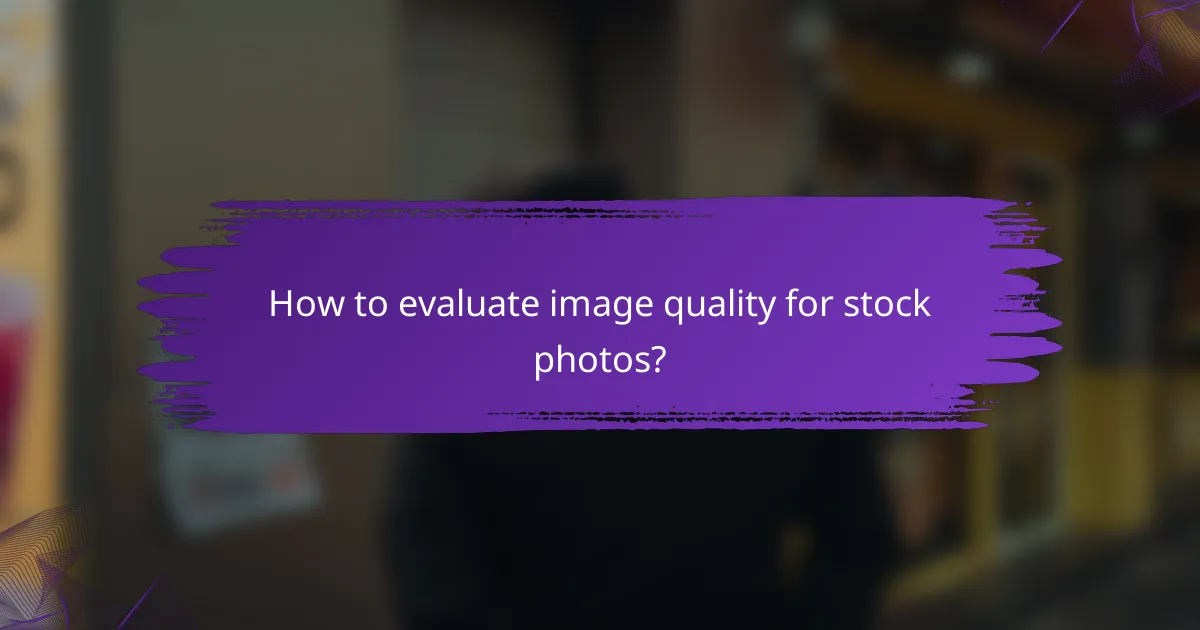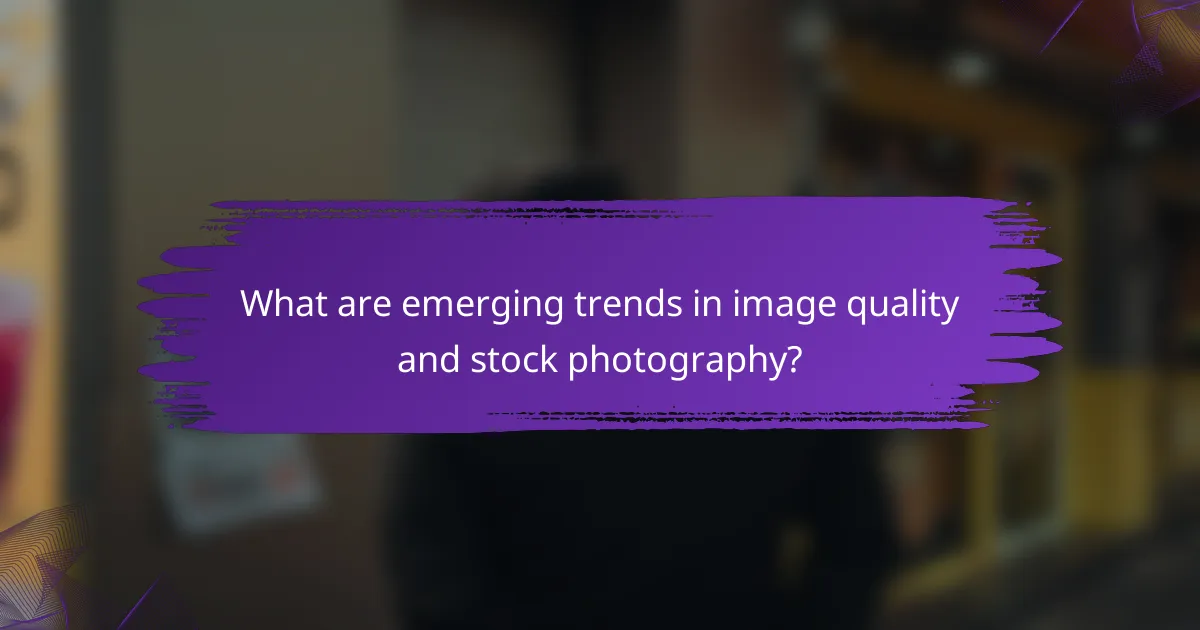Image quality plays a crucial role in the evaluation of stock photos, with key factors such as resolution, color accuracy, and composition significantly influencing their visual appeal. Understanding these elements not only aids photographers in selecting the right equipment but also enhances the viewer’s engagement and emotional response to the content. By prioritizing high-quality images, creators can ensure a lasting impression and improve overall user experience.

How to evaluate image quality for stock photos?
To evaluate image quality for stock photos, consider key factors such as resolution, color accuracy, composition, lighting, and file format. Each of these elements contributes to the overall visual appeal and usability of the image in various contexts.
Resolution and clarity
Resolution refers to the amount of detail an image holds, typically measured in pixels. High-resolution images (generally above 300 DPI for print and 72 DPI for web) ensure clarity and sharpness, making them suitable for various applications.
When evaluating stock photos, check the dimensions in pixels. A common guideline is to look for images that are at least 2000 pixels on the shortest side for versatile use. Low-resolution images may appear pixelated when enlarged, diminishing their quality.
Color accuracy
Color accuracy is crucial for ensuring that the hues in an image reflect reality or the intended aesthetic. This can be assessed by comparing the colors in the photo to a color reference or using calibrated monitors.
Look for images that have vibrant, true-to-life colors without excessive saturation or dullness. Images that are too warm or cool can misrepresent the subject, affecting their usability in marketing or editorial contexts.
Composition and framing
Composition involves the arrangement of visual elements within the frame. A well-composed image draws the viewer’s eye and effectively communicates the intended message.
Consider the rule of thirds, leading lines, and balance when evaluating stock photos. Images that are cluttered or poorly framed can distract from the subject, making them less appealing for use in projects.
Lighting and exposure
Lighting impacts the mood and clarity of an image. Proper exposure ensures that details are visible in both highlights and shadows, while poor lighting can lead to washed-out or overly dark images.
When assessing stock photos, look for even lighting that enhances the subject. Natural light often yields the best results, but well-executed artificial lighting can also be effective. Avoid images with harsh shadows or glare that obscure details.
File format and compression
The file format affects both the quality and usability of an image. Common formats include JPEG, PNG, and TIFF, each with different characteristics regarding compression and quality retention.
For high-quality stock photos, prefer formats like TIFF for print use due to their lossless compression. JPEGs are suitable for web use but can lose detail if compressed too much. Always check the compression level to ensure that image quality is not compromised.

What are the key factors affecting image quality?
Image quality is influenced by several key factors, including sensor quality, lens specifications, and post-processing techniques. Understanding these elements can help photographers and designers select the right equipment and methods to achieve the desired visual appeal.
Sensor quality in cameras
The sensor quality in cameras plays a crucial role in determining image quality. Higher-quality sensors can capture more detail, produce better color accuracy, and handle low-light conditions more effectively. Look for sensors with larger physical sizes, as they typically offer better performance in various lighting situations.
When evaluating sensors, consider factors such as resolution (measured in megapixels), dynamic range, and noise performance. For instance, a full-frame sensor generally outperforms an APS-C sensor in low-light scenarios, making it a preferred choice for professional photographers.
Lens specifications
Lens specifications significantly impact the sharpness and clarity of images. Key factors include focal length, aperture size, and lens construction. A lens with a wide aperture (like f/1.8) allows more light to enter, which is beneficial for low-light photography and achieving a shallow depth of field.
Additionally, consider lens quality indicators such as optical design and coatings. High-quality lenses often feature multiple elements and specialized coatings to reduce flare and enhance contrast, resulting in sharper images. Investing in good lenses can greatly enhance overall image quality.
Post-processing techniques
Post-processing techniques are essential for refining image quality after capture. Software like Adobe Lightroom or Photoshop allows photographers to adjust exposure, contrast, and color balance, enhancing the final output. Basic adjustments can significantly improve the overall appeal of an image.
Be mindful of over-processing, which can lead to unnatural results. Aim for a balanced approach, focusing on subtle enhancements rather than drastic changes. Familiarize yourself with common techniques such as sharpening, noise reduction, and color correction to elevate your images effectively.

How does image quality impact visual appeal?
Image quality significantly influences visual appeal by affecting how viewers perceive and engage with content. High-quality images attract attention, evoke emotions, and create a lasting impression, which can enhance overall user experience.
First impressions and engagement
First impressions are crucial in capturing audience attention, and image quality plays a pivotal role in this process. High-resolution, well-composed images can draw viewers in, while poor-quality visuals may lead to immediate disengagement. Aim for images that are sharp, vibrant, and relevant to the content to maximize engagement.
Consider using images that reflect the tone and message of your brand. For instance, a clean and professional image may work well for corporate websites, while more dynamic and colorful visuals might suit creative industries better.
Brand perception and trust
Image quality directly affects brand perception and trustworthiness. Brands that consistently use high-quality visuals are often seen as more credible and professional. Conversely, low-quality images can create doubt about a brand’s reliability and attention to detail.
To build trust, ensure that all images align with your brand identity and maintain a consistent style. This includes using similar color palettes, themes, and image types across platforms. Regularly updating visuals can also signal that your brand is active and engaged.
Conversion rates and sales
High-quality images can significantly boost conversion rates and sales by enhancing the overall appeal of products or services. Studies suggest that consumers are more likely to purchase items that are showcased with clear, detailed images. Investing in professional photography or high-quality stock photos can lead to better sales outcomes.
When displaying products, consider using multiple angles and close-ups to provide a comprehensive view. Additionally, incorporating lifestyle images that show products in use can help potential customers envision themselves using the product, further driving conversions.

What are the best practices for selecting stock photos?
Selecting stock photos effectively involves understanding your audience, assessing usage rights, and choosing reliable platforms. These practices ensure that the images you choose resonate with viewers and comply with legal standards.
Understanding target audience needs
Identifying your target audience is crucial when selecting stock photos. Consider factors such as demographics, interests, and cultural backgrounds to choose images that will appeal to them. For example, a tech-savvy audience may prefer modern, sleek visuals, while a family-oriented audience might respond better to warm, relatable images.
Conducting surveys or analyzing existing content can provide insights into what types of visuals attract your audience. Tailoring your selection to these preferences enhances engagement and effectiveness.
Assessing licensing and usage rights
Before using stock photos, it’s essential to understand the licensing and usage rights associated with each image. Stock photos typically come with various licenses, such as royalty-free or rights-managed, which dictate how you can use the images. Ensure that the license aligns with your intended use—whether for commercial purposes, social media, or print.
Be cautious of images that require attribution or have restrictions on modifications. Always read the fine print to avoid potential legal issues or unexpected costs.
Choosing reputable stock photo platforms
Selecting a reliable stock photo platform can significantly impact the quality and variety of images available. Look for platforms that offer high-resolution images, diverse categories, and transparent licensing options. Popular platforms include Shutterstock, Adobe Stock, and Getty Images, each providing different strengths in terms of content and pricing.
Consider user reviews and ratings to gauge the platform’s reliability and customer service. A good platform should also offer a user-friendly interface and effective search tools to help you find the right images quickly.

How to optimize images for web use?
To optimize images for web use, focus on reducing file size without sacrificing quality, ensuring fast loading times and a better user experience. Key techniques include resizing images, using descriptive alt text, and implementing lazy loading to enhance performance.
Image resizing and dimensions
Image resizing involves adjusting the pixel dimensions of an image to fit the specific needs of your website. Aim for dimensions that match the display size to avoid unnecessary loading of large files. For example, if an image will be displayed at 800×600 pixels, resizing it to those dimensions can significantly reduce file size.
Consider using tools like Adobe Photoshop or online services to batch resize images. A good practice is to keep file sizes under 100 KB for faster loading, especially for mobile users. Additionally, use appropriate formats like JPEG for photographs and PNG for images with transparency.
Using alt text effectively
Alt text serves as a textual alternative for images, improving accessibility and SEO. It should accurately describe the image content and context, ideally including relevant keywords without keyword stuffing. For instance, instead of “image1,” use “golden retriever playing fetch in the park.”
Keep alt text concise, ideally under 125 characters, to ensure it is fully read by screen readers. This not only aids visually impaired users but also helps search engines understand the image, potentially improving your site’s visibility in search results.
Implementing lazy loading techniques
Lazy loading is a technique that delays the loading of images until they are needed, such as when they come into the user’s viewport. This can significantly improve initial page load times and reduce bandwidth usage. Implement lazy loading using the native loading attribute in HTML by setting loading="lazy" on image tags.
For better performance, consider using JavaScript libraries that support lazy loading for more complex scenarios. This method is particularly beneficial for long pages with many images, as it ensures that only the images currently in view are loaded, enhancing the overall user experience.

What are emerging trends in image quality and stock photography?
Emerging trends in image quality and stock photography focus on the integration of technology and evolving consumer preferences. Key developments include the rise of AI-generated images, increased demand for authenticity, and the growing importance of visual storytelling.
AI-generated images
AI-generated images are becoming increasingly prevalent in stock photography, offering a new way to create visuals quickly and cost-effectively. These images are produced using algorithms that analyze existing photos to generate new content that meets specific themes or styles.
When evaluating AI-generated images, consider factors such as originality, relevance to your project, and the potential for copyright issues. While these images can be tailored to fit particular needs, they may lack the emotional depth and authenticity often found in traditional photography.
As AI technology continues to evolve, it’s essential to stay updated on the quality and capabilities of these images. Always compare AI-generated options with human-created stock photos to ensure you select visuals that resonate with your audience and enhance your message.
